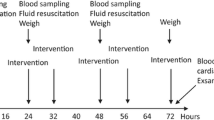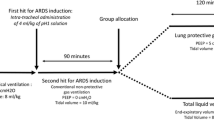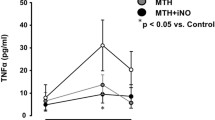Abstract
Sepsis is often associated with upregulation of nitric oxide production and fever, and it is common to control an excessive febrile response with antipyretic therapy and external cooling. Our aim was to evaluate the effect of hypothermia on NO production in a model of septic shock. Rats were anesthetized, ventilated, and instrumented for hemodynamic monitoring and divided into four groups. Normothermic controls (NC) received saline intravenously and were maintained at 37 °C. Hypothermic controls (HC) received saline but were allowed to become hypothermic. Normothermic endotoxic (NE) received Escherichia Coli lipopolysaccharides (LPS) intravenously to induce endotoxic shock and was maintained at 37 °C. Hypothermic endotoxic (HE) received LPS intravenously and was allowed to become hypothermic. Exhaled NO (NOe) was measured from mixed expired gas at time zero and every 30 min, for 5 h. After injection of LPS, NOe increased substantially in the NE group (700 ± 24 ppb), but increased only to 25 ± 2 ppb in the HE group. NOe increased to 90 ± 3 ppb in the NC group, and to 17.6 ± 3.1 ppb in the HC group after 5 h (P < 0.05), whilst blood pressure remained stable. In the HE group, blood pressure fell immediately after injection of the LPS, but thereafter remained stable despite the rise in NOe. In the NE group, the blood pressure fell gradually, and the animals became hypotensive. During the natural course of endotoxemia in anesthetized rats, allowing severe hypothermia to ensue by not actively managing temperature and hemodynamics resulted in significantly reduced expired NO concentrations, lung injury, and prolonged survival. The clinical benefits of such a finding currently remain unclear and merit further investigation.





Similar content being viewed by others
References
Aaron SD, Valenza F, Volgyesi G, Mullen JB, Slutsky AS, Stewart TE (1998) Inhibition of exhaled nitric oxide production during sepsis does not prevent lung inflammation. Crit Care Med 26:309–314
Atwood RP, Kass EH (1964) Relationship of body temperature to the lethal action of bacterial endotoxin. J Clin Invest 43:151–169
Barthlen W, Stadler J, Lehn NL, Miethke T, Bartels H, Siewert JR (1994) Serum levels of end products of nitric oxide synthesis correlate positively with tumor necrosis factor alpha and negatively with body temperature in patients with postoperative abdominal sepsis. Shock 2:398–401
Bernard C, Merval R, Esposito B, Tedgui A (1994) Elevated temperature accelerates and amplifies the induction of nitric oxide synthesis in rat macrophages. Eur J Pharmacol 270:115–118
Bernard SA, Buist M (2003) Induced hypothermia in critical care medicine: a review. Crit Care Med 31:2041–2051
Blair E, Henning G, Hornick R, Cowley RA (1964) Hypothermia in bacteremic shock. Arch Surg 89:619–629
Bone RC (1994) Sepsis and its complications: the clinical problem. Crit Care Med 22:S8–S11
Branco LG, Carnio EC, Barros RC (1997) Role of the nitric oxide pathway in hypoxia-induced hypothermia of rats. Am J Physiol 273:R967–R971
Chu SJ, Perng WC, Hung CM, Chang DM, Lin SH, Huang KL (2005) Effects of various body temperatures after lipopolysaccharide-induced lung injury in rats. Chest 128:327–336
Clemmer TP, Fisher CJ Jr, Bone RC, Slotman GJ, Metz CA, Thomas FO (1992) Hypothermia in the sepsis syndrome and clinical outcome. The Methylprednisolone Severe Sepsis Study Group. Crit Care Med 20:1395–1401
Gilston A (1993) Induced hypothermia for sepsis? Crit Care Med 21:1247–1248
Gourine AV (1995) Pharmacological evidence that nitric oxide can act as an endogenous antipyretic factor in endotoxin-induced fever in rabbits. Gen Pharmacol 26:835–841
Harris RL, Musher DM, Bloom K, Gathe J, Rice L, Sugarman B, Williams TW Jr, Young EJ (1987) Manifestations of sepsis. Arch Intern Med 147:1895–1906
Ischiropoulos H, Zhu L, Beckman JS (1992) Peroxynitrite formation from macrophage-derived nitric oxide. Arch Biochem Biophys 298:446–451
Kellogg DL Jr, Crandall CG, Liu Y, Charkoudian N, Johnson JM (1998) Nitric oxide and cutaneous active vasodilation during heat stress in humans. J Appl Physiol (1985) 85:824–829
Lim CM, Kim MS, Ahn JJ, Kim MJ, Kwon Y, Lee I, Koh Y, Kim DS, Kim WD (2003) Hypothermia protects against endotoxin-induced acute lung injury in rats. Intensive Care Med 29:453–459
Mills PC, Scott CM, Marlin DJ (1997) Effects of nitric oxide inhibition on thermoregulation during exercise in the horse. Ann N Y Acad Sci 813:591–599
Moncada S, Higgs A (1993) The l-arginine-nitric oxide pathway. N Engl J Med 329:2002–2012
Moonka R, Gentilello L (1996) Hypothermia induced by continuous arteriovenous hemofiltration as a treatment for adult respiratory distress syndrome: a case report. J Trauma 40:1026–1028
Nava E, Palmer RM, Moncada S (1991) Inhibition of nitric oxide synthesis in septic shock: how much is beneficial? Lancet 338:1555–1557
Ochoa JB, Udekwu AO, Billiar TR, Curran RD, Cerra FB, Simmons RL, Peitzman AB (1991) Nitrogen oxide levels in patients after trauma and during sepsis. Ann Surg 214:621–626
Pedoto A, Nandi J, Yang ZJ, Wang J, Bosco G, Oler A, Hakim TS, Camporesi EM (2003) Beneficial effect of hyperbaric oxygen pretreatment on lipopolysaccharide-induced shock in rats. Clin Exp Pharmacol Physiol 30:482–488
Pedoto A, Wang J, Tassiopoulos AK, Hakim TS, Yang ZJ, Camporesi EM (2002) Hypotension during septic shock does not correlate with exhaled nitric oxide in anesthetized rat. Shock 17:427–432
Pernerstorfer T, Krafft P, Fitzgerald R, Fridrich P, Koc D, Hammerle AF, Steltzer H (1995) Optimal values for oxygen transport during hypothermia in sepsis and ARDS. Acta Anaesthesiol Scand Suppl 107:223–227
Pryor WA, Squadrito GL (1995) The chemistry of peroxynitrite: a product from the reaction of nitric oxide with superoxide. Am J Physiol 268:L699–L722
Romanovsky AA, Shido O, Sakurada S, Sugimoto N, Nagasaka T (1997) Endotoxin shock-associated hypothermia. How and why does it occur? Ann N Y Acad Sci 813:733–737
Ryan M, Levy MM (2003) Clinical review: fever in intensive care unit patients. Crit Care 7:221–225
Scammell TE, Elmquist JK, Saper CB (1996) Inhibition of nitric oxide synthase produces hypothermia and depresses lipopolysaccharide fever. Am J Physiol 271:R333–R338
Schortgen F, Clabault K, Katsahian S, Devaquet J, Mercat A, Deye N, Dellamonica J, Bouadma L, Cook F, Beji O, Brun-Buisson C, Lemaire F, Brochard L (2012) Fever control using external cooling in septic shock: a randomized controlled trial. Am J Respir Crit Care Med 185:1088–1095
Schulman CI, Namias N, Doherty J, Manning RJ, Li P, Elhaddad A, Lasko D, Amortegui J, Dy CJ, Dlugasch L, Baracco G, Cohn SM (2005) The effect of antipyretic therapy upon outcomes in critically ill patients: a randomized, prospective study. Surg Infect (Larchmt) 6:369–375
Scumpia PO, Sarcia PJ, DeMarco VG, Stevens BR, Skimming JW (2002) Hypothermia attenuates iNOS, CAT-1, CAT-2, and nitric oxide expression in lungs of endotoxemic rats. Am J Physiol Lung Cell Mol Physiol 283:L1231–L1238
Stamler JS, Singel DJ, Loscalzo J (1992) Biochemistry of nitric oxide and its redox-activated forms. Science 258:1898–1902
Stewart TE, Valenza F, Ribeiro SP, Wener AD, Volgyesi G, Mullen JB, Slutsky AS (1995) Increased nitric oxide in exhaled gas as an early marker of lung inflammation in a model of sepsis. Am J Respir Crit Care Med 151:713–718
Strunk V, Hahnenkamp K, Schneuing M, Fischer LG, Rich GF (2001) Selective iNOS inhibition prevents hypotension in septic rats while preserving endothelium-dependent vasodilation. Anesth Analg 92:681–687
Su F, Nguyen ND, Wang Z, Cai Y, Rogiers P, Vincent JL (2005) Fever control in septic shock: beneficial or harmful? Shock 23:516–520
Szabo C, Salzman AL (1997) The physiology and pathophysiology of nitric oxide in the lung. The Pediatric Lung. Birkhäuser Basel, pp. 279–310
Taniguchi T, Kanakura H, Takemoto Y, Yamamoto K (2003) Effects of hypothermia on mortality and inflammatory responses to endotoxin-induced shock in rats. Clin Diagn Lab Immunol 10:940–943
Taylor WF, Bishop VS (1993) A role for nitric oxide in active thermoregulatory vasodilation. Am J Physiol 264:H1355–H1359
Villar J, Slutsky AS (1993) Effects of induced hypothermia in patients with septic adult respiratory distress syndrome. Resuscitation 26:183–192
Wang D, Wei J, Hsu K, Jau J, Lieu MW, Chao TJ, Chen HI (1999) Effects of nitric oxide synthase inhibitors on systemic hypotension, cytokines and inducible nitric oxide synthase expression and lung injury following endotoxin administration in rats. J Biomed Sci 6:28–35
Wilkins BW, Holowatz LA, Wong BJ, Minson CT (2003) Nitric oxide is not permissive for cutaneous active vasodilatation in humans. J Physiol 548:963–969
Wolfe TA, Dasta JF (1995) Use of nitric oxide synthase inhibitors as a novel treatment for septic shock. Ann Pharmacother 29:36–46
Zhang L, Kumar S, Kaminski A, Kasch C, Sponholz C, Stamm C, Ladilov Y, Steinhoff G (2006) Importance of endothelial nitric oxide synthase for the hypothermic protection of lungs against ischemia-reperfusion injury. J Thorac Cardiovasc Surg 131:969–974
Acknowledgments
Supported by funding from the Departments of Anesthesiology and Medicine, SUNY Health Science, Syracuse, NY.
Conflict of interest
The authors declare that they have no competing interests.
Author information
Authors and Affiliations
Corresponding author
Rights and permissions
About this article
Cite this article
Hakim, T.S., Pedoto, A., Nandi, J. et al. Hypothermia attenuates NO production in anesthetized rats with endotoxemia. Naunyn-Schmiedeberg's Arch Pharmacol 387, 659–665 (2014). https://doi.org/10.1007/s00210-014-0977-1
Received:
Accepted:
Published:
Issue Date:
DOI: https://doi.org/10.1007/s00210-014-0977-1




